Roof lightning protection systems are essential to protect buildings from lightning. Occupants and property are at risk if lightning strikes a building that doesn’t have one of these protective systems installed. In this guide, we’ll provide valuable information for both roofers and property managers about the different kinds of lightning protection systems and how they function.
First, for property owners and managers, understanding these systems will help you make better decisions so that you can protect the occupants and property in your building. While lightning is rare, it is a risk. Strikes cause more than a billion dollars of damages to structures annually in the United States, according to Underwriters Laboratories (UL). This guide will walk you through how different lightning protection systems work to minimize the risk.
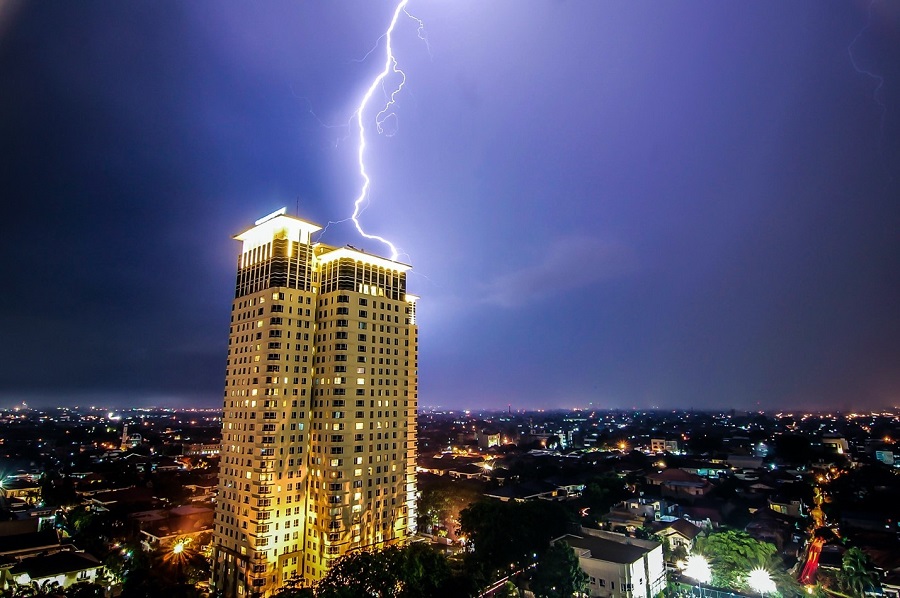
Secondly, for commercial roofing professionals, understanding lightning protection systems is essential to ensure that any your work will not interfere with them, and that the lightning systems also won’t interfere with the roofs you install. Both systems will only work if they are in good condition and work in harmony with one another. In this guide, we’ll detail how these two systems impact each other and how roofers can resolve common issues they face when working on a roof with a lightning protection system.
What is a Lightning Protection System?
Most lightning protection systems are interception systems that don’t reduce the odds that lightning will strike a building. Instead, they mitigate the risks of a lightning strike by controlling and harmlessly dispersing the energy they create. These systems are intended to guide the lightning discharge safely to the ground, ideally without impacting anything inside.
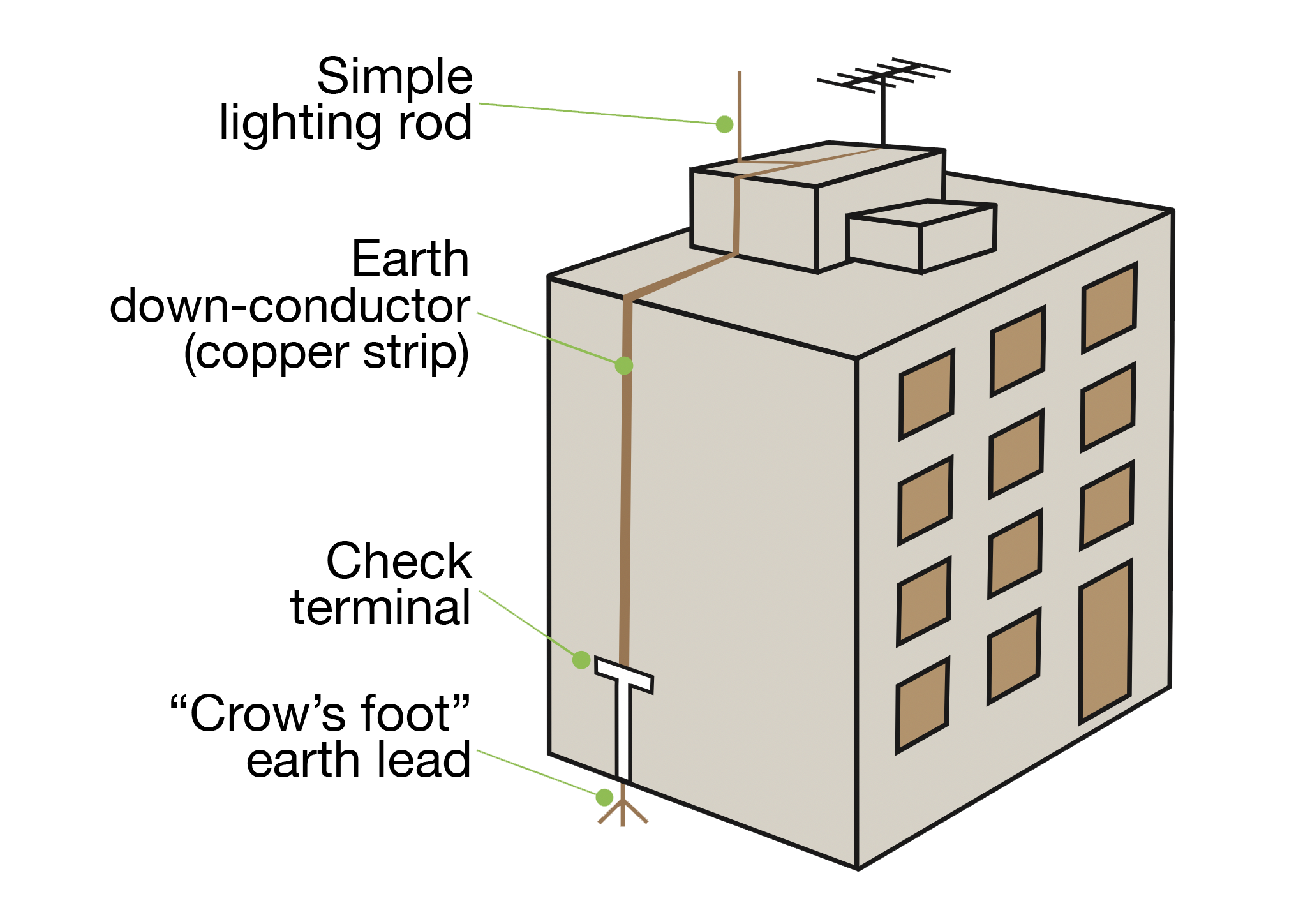
The system does more than just capture the energy of the lightning strike. It must bring the energy to the ground without impacting the building’s structure or the electrical equipment inside. Lightning can also generate a significant amount of heat. The protection system must minimize the impact of this heat from the strike so that it doesn’t create a fire or melt building components.
There are different lightning protection systems available, many with custom elements that can meet your building’s specific needs.
How Does a Lightning Protection System Work?
A lightning interception system creates a preferred strike point for lightning and safely runs the energy to the ground to spare the building and the occupants.
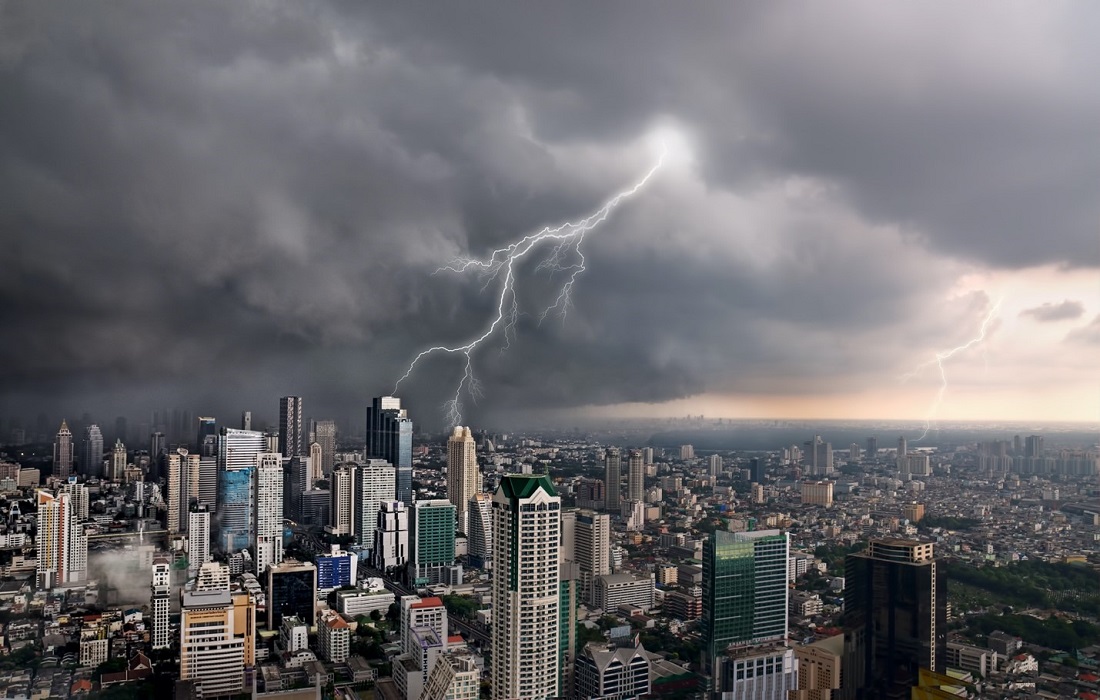
It all starts with the strike termination devices. Lightning is predictable in that it prefers to strike the highest point of a structure and prefers to hit a conductive metal. The rods create a preferred point of strike. A strike termination device needs to be the highest point of the building and made of a conductive metal to attract the strike.
Further, large buildings require wider coverage. So, their protection systems are often designed with multiple strike termination devices. According to Underwriters Laboratories (UL), terminals that are 10 inches in height need to be no more than 20 feet apart in order to provide adequate protection to the building below. System installers may place taller terminals further apart.
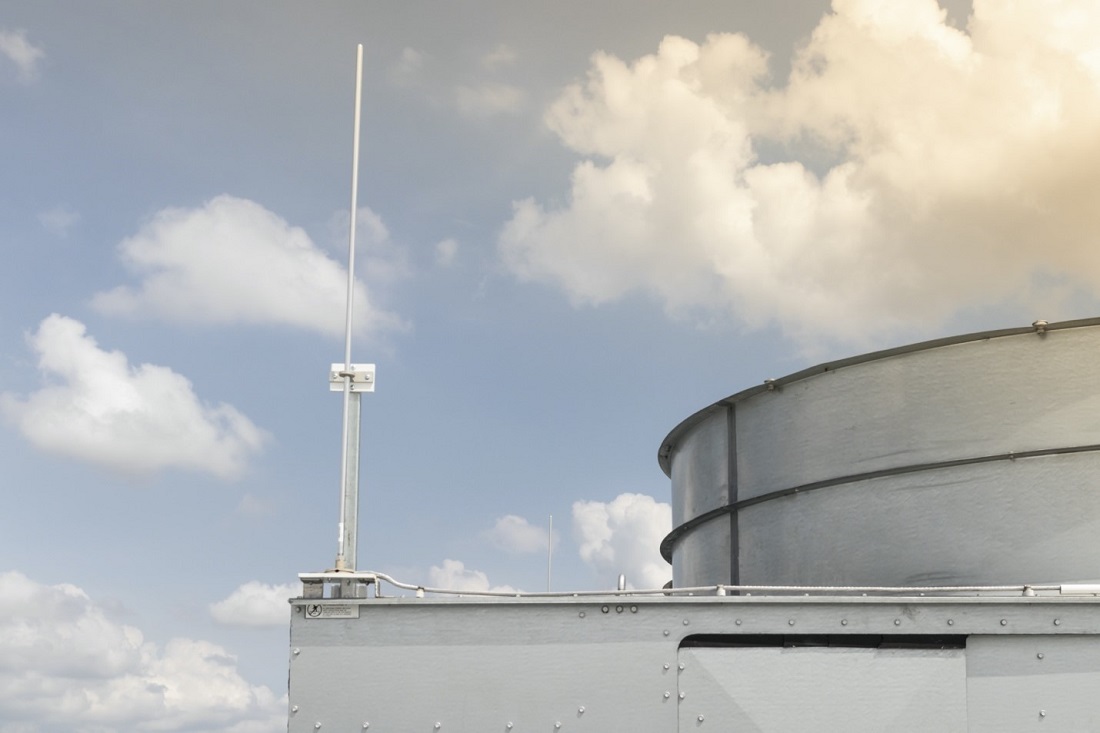
Lightning protection systems direct the energy of the lightning strike through cables. The cables run from the termination devices along the edges of the roof and then down through the building. There will be bonding, or fittings, to secure the cable to the roof. In a Faraday Cage lightning protection system, the cables create a net over the whole building. Along the roof, there will be extra fittings joining various cables together to make the next.
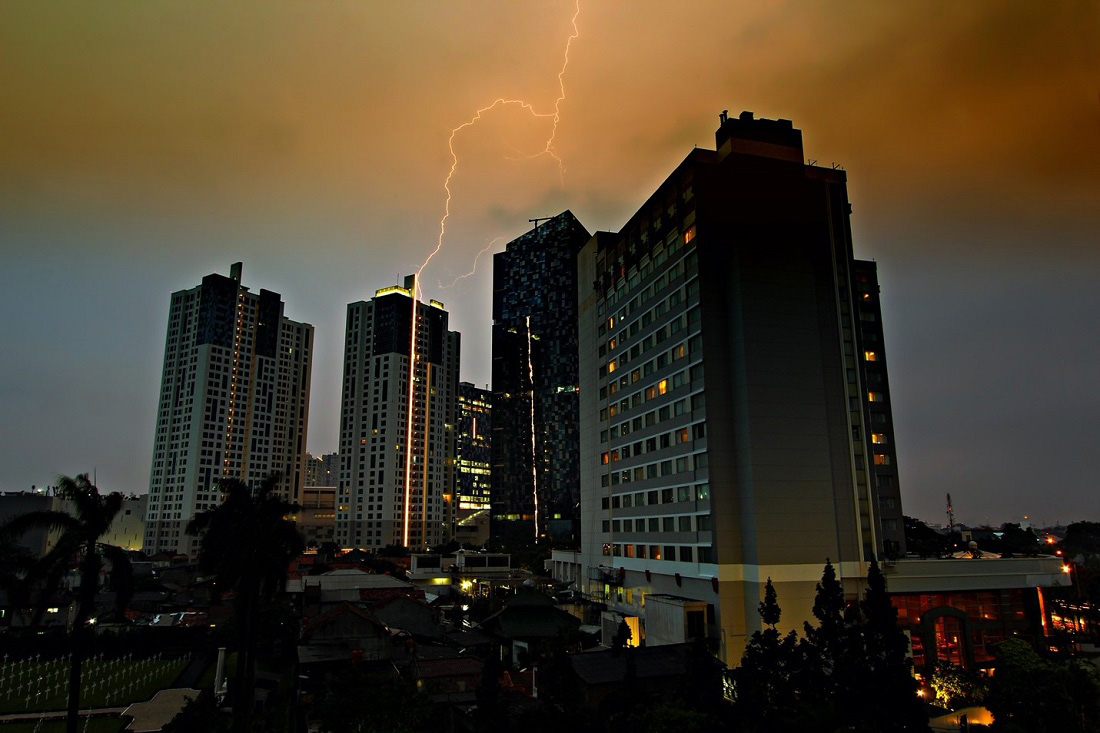
From the cables, the energy is passed onto a grounding mechanism, which allows the energy of the strike to be dispersed into the ground where it can’t do any harm.
However, other newer and more complicated lightning protection systems work differently, including:
- Lightning attraction systems: While the interception systems passively collect lightning that was already going to strike in a given area, these systems actively attract lightning to a specific spot. By doing so, they provide protection to a much larger area than interception systems. Frequently, lightning attraction systems have a single rod. They, therefore, require fewer materials and less time to install. They are often chosen in situations where making a whole net of cables is cost-prohibitive or challenging to design and install.There are two main examples of lightning attraction systems: Early Streamer Emission (ESE) and Electronically Activated Streamer Emission (EASE). Both build up electrical charge before a storm and then send out a stream of that charge before anything else in the area. This stream attracts any lightning that would have struck in an exceptionally large area.
- Lightning prevention systems: These lightning protection systems attempt the opposite feat. They actively prevent lightning from striking in a certain area. There are two types of lightning prevention systems: Dissipation Array Systems (DAS) or Charge Transfer Systems (CTS). They use a charge dissipation terminal to release the static building up near the ground during thunderstorms. Without that charge, a streamer cannot form. Therefore, the whole area is an unappealing target for lightning, and it will instead strike somewhere outside of the range of the system, where it can meet a streamer.
Every manufacturer has a slightly different take on these systems, and your building may need a custom solution. You should only use a lightning protection system that is approved by the Underwriters Laboratories (UL), and the other relevant safety authorities in your area.
The Basic Parts of a Lightning Protection System
The most basic type of lightning protection system is a lightning interception system. There are two basic variations on this system: Franklin rod lightning protection systems and Faraday Cage lightning protection systems. Franklin systems typically rely on one rod, while Faraday Cage systems have multiple rods and create a mesh from the cables.
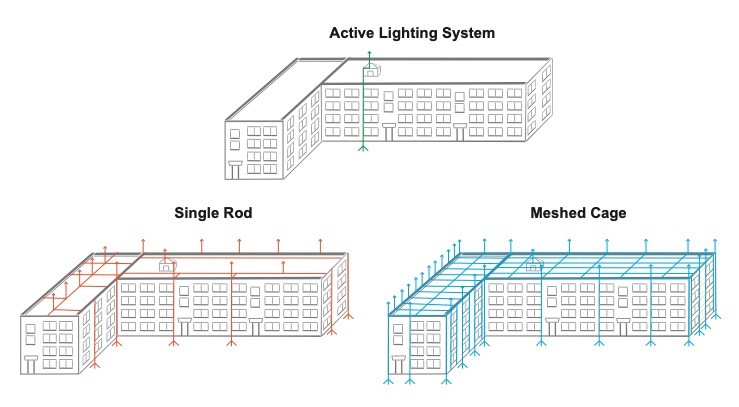
There are five basic parts of a lightning interception protection system:
- Strike termination devices: Also called a lightning rod, Franklin rod, or air terminal, these devices are positioned along the roof. While they used to be sharply pointed, most are now rounded as research demonstrated rounded tips were better at conducting the strike. Plus, rounded tips are safer for roofers to work near. There are different air terminals for different spots on the roof. Faraday cage lightning protection systems have more terminals than Franklin rod systems and can protect larger buildings.
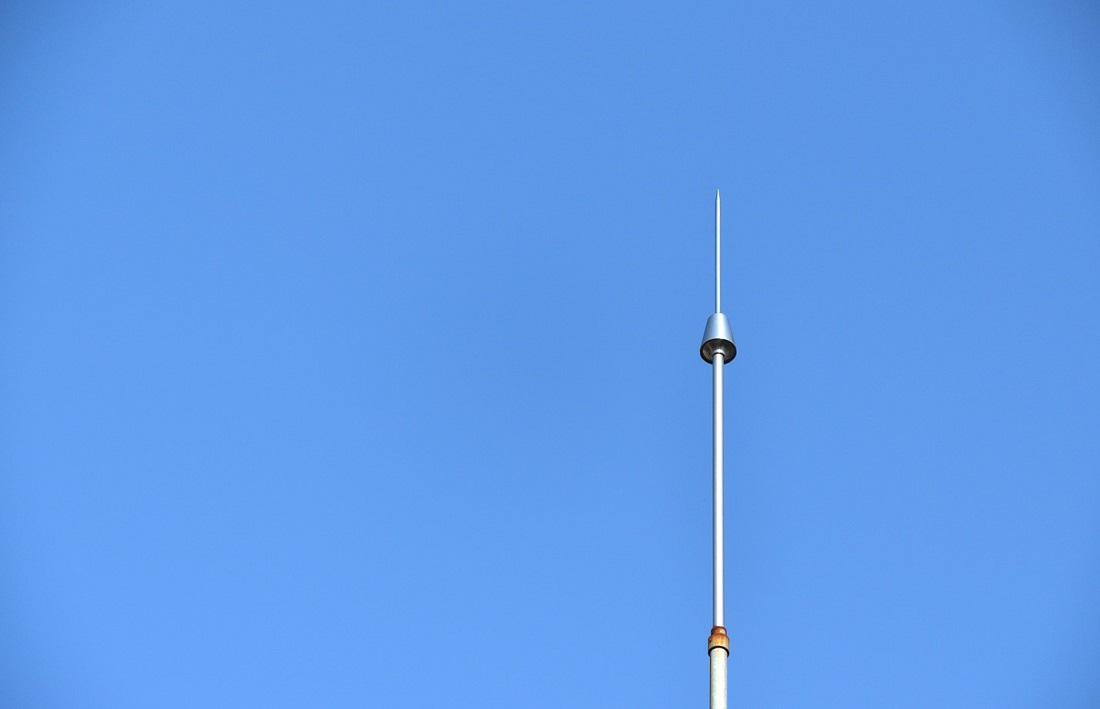
- Conductor cable: The cable connects the strike to the grounding. The cable can be made of copper or aluminum. The cable’s weight or gauge depends on the height of the building and how far the cable must conduct the strike. You won’t find them in normal AWG sizes, and they have special multi-strand construction (either continuous or smooth.)
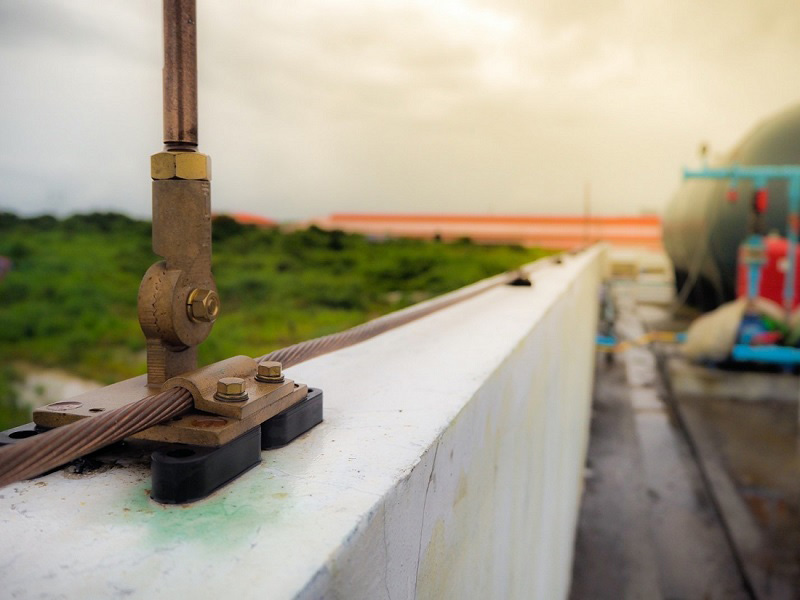
- Bonding: As you follow the cable along the edge of the roof, you may find fittings and splicers that hold the cable down or which combine multiple cables together. These bondings may be bronze, copper or aluminum. It is important that they are a compatible metal with the surface they are mounted on. They may be mounted on roof drains, flashing, and more.
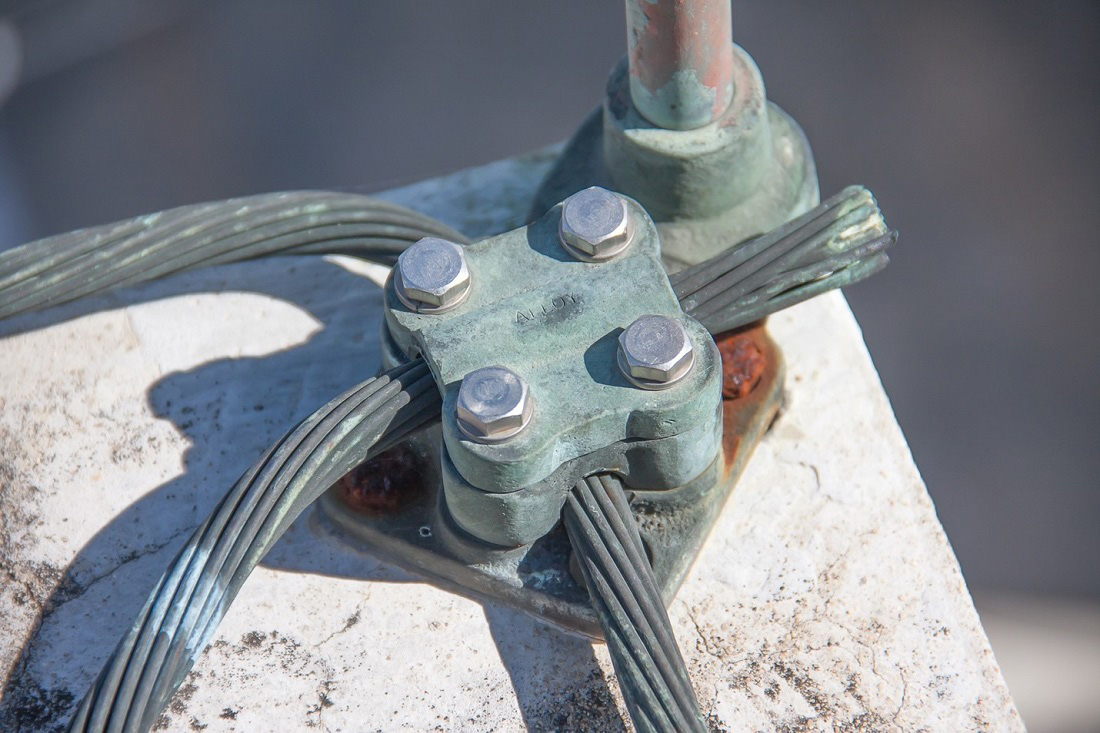
- Grounding: The system must be permanently and properly grounded in order to disperse a lightning strike safely. High resistance connections may cause failure. Grounding may include buried rods, plates, or cable grids. The grounding may be encapsulated or buried with chemical backfill to lower the system’s resistance. Lowering the system’s electrical resistance allows the lightning to be discharged more successfully into the ground.
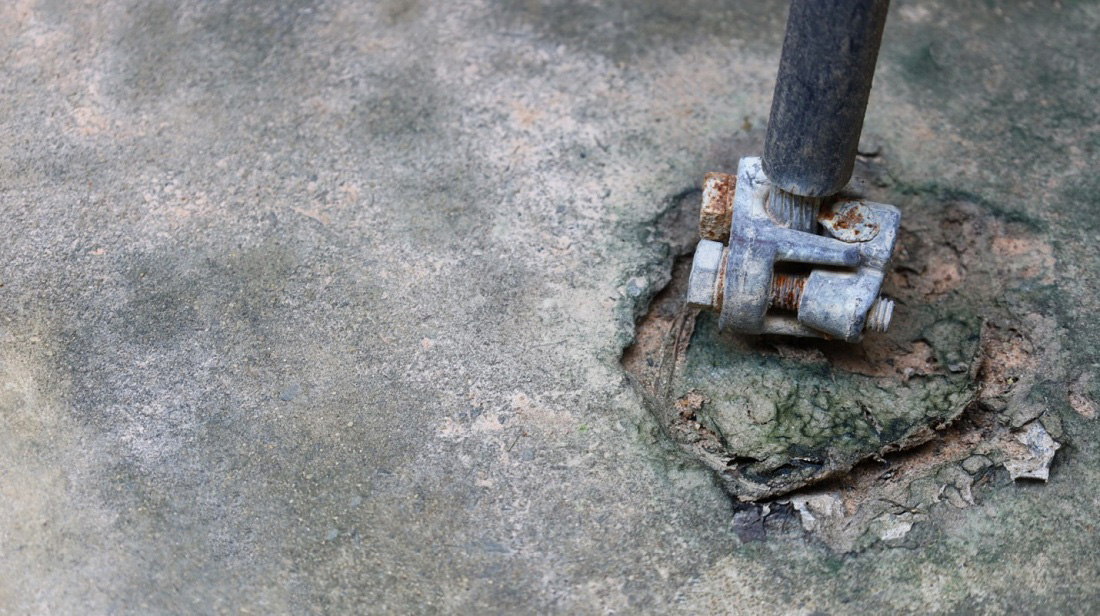
- Surge protection: Surge protection devices should be installed on every service entrance to stop utility lines from spreading lightning into the building.
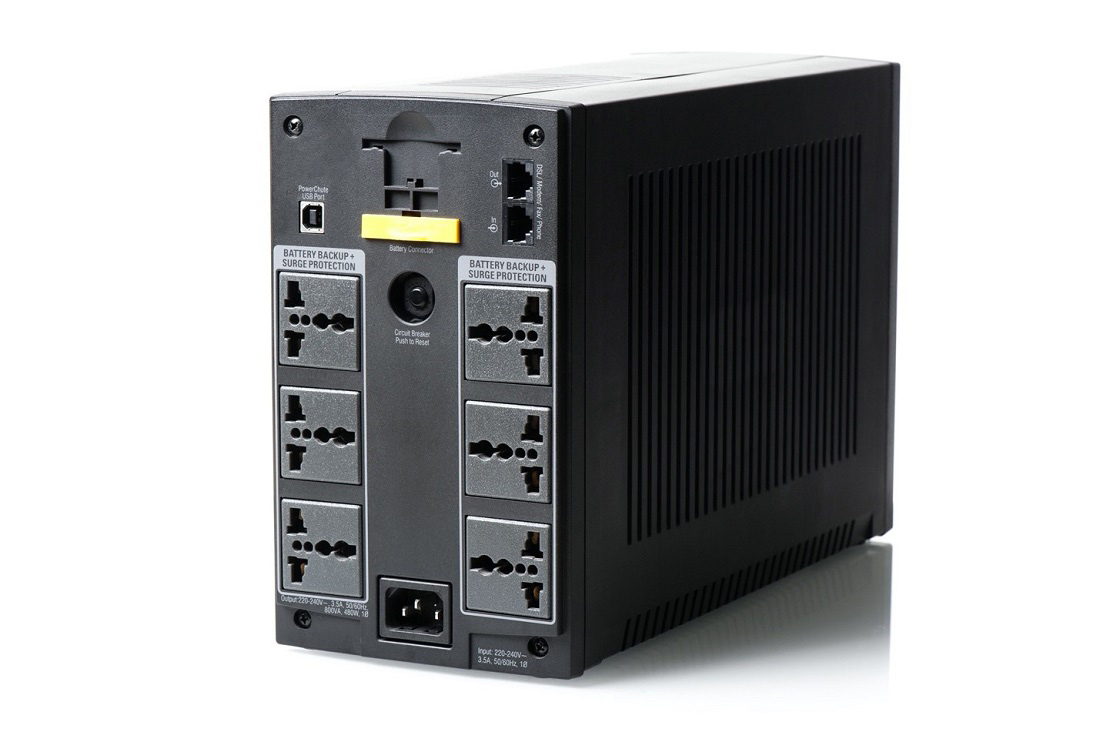
Each system’s design is different, but these basic elements are present in all interception lightning protection systems. Further, some lightning protection systems will have higher quality or more sophisticated elements to minimize the specific risks of the property. For example, they might have electrolytic rods to disperse the electricity into the ground better. Or, they may have active soil moisture replenishment.
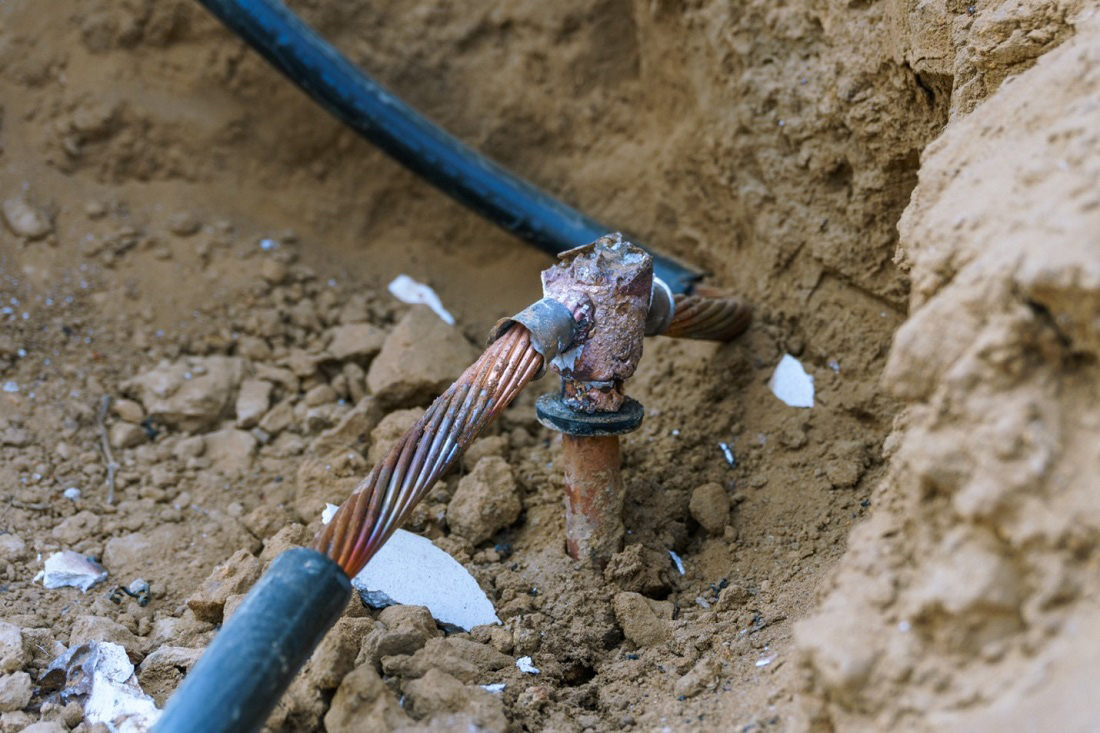
Is Lightning Protection Required?
In Canada, The National Building Code does not mandate lightning protection on most buildings. Provincial building codes also rarely mandate lightning protection systems. However, due to the ubiquity of sensitive electronic equipment, and sensitivity to other risks from lightning strikes, most commercial buildings have lightning protection anyway. You can find official guidance on the parts and installation of lightning protection systems from the following sources:
- Canada Standards Association CSA B72 Installation Code for Lightning Protection Systems.
- Underwriters Laboratories UL96 Lightning Protection Components and UL96A Installation Requirements.
- National Fire Protection Association NFPA 780 Standard for the Installation of Lightning Protection Systems.
- Lightning Protection Institute LPI 175 Standard of Practice.
You should look into your specific local standards to see if there are more guidelines or building codes that may apply to your lightning protection system. For example, in Ontario, the system must meet the conditions of the Lightning Rods Act of the Fire Marshal’s Office of Ontario.
In addition, once your lightning protection system is installed, you should get it certified by UL. UL installation certifications must be renewed after five years.
What Happens Without Lightning Protection?
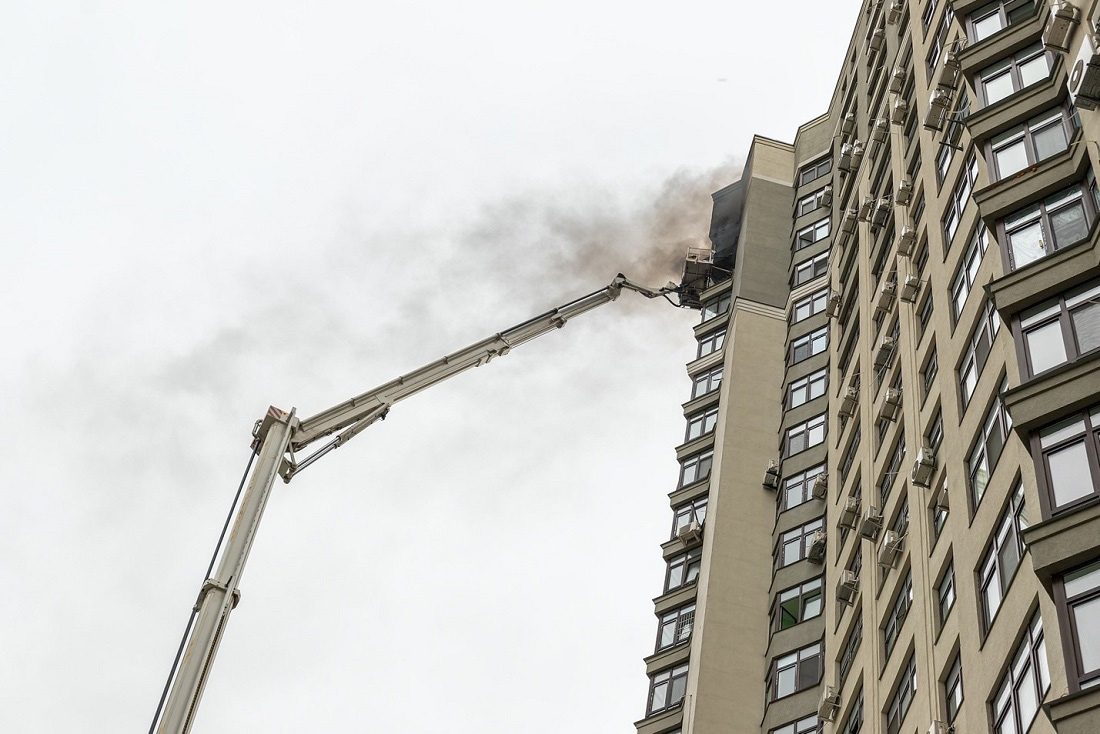
While lightning protection systems may not be strictly required in your area, it is still wise to have one installed in your building. Without lightning protection, you are risking serious harm to people and the property. The risks include:
- Damages: Lightning strikes may damage the building’s structure, including the roof and walls. Further, the energy from the strike may damage internal components of the building, including its own electrical system and sensitive machinery and electronics stored inside. Your stock, inventory and other items may also be damaged from the strike.
- Fires: Undirected lightning strikes may cause fires in the building, either from the strike itself or the electrical system damage that can result. The combustibility of the roof is not the only factor, as lightning can start fires in other parts of the building.
- Injuries: Most importantly, a lightning strike may cause serious bodily injury or death to a person either directly or indirectly. There are many sources of potential injuries to your staff, customers, and guests. They may be injured by the strike itself, falling debris, fire, smoke, and electrical hazards such as malfunctions and failures.
- Downtime: It may take you significant time to recover from a lightning strike and resume work in the building. Repairs and replacement may be expensive and time-consuming particularly if there is sensitive and expensive equipment in the building.
- Liability: Without a functional lightning protection system, you open yourself up to liability. Anyone harmed in the strike may pursue a legal case against you.
How Roofing Systems and Lightning Protection Systems Impact One Another
Roofing systems and lightning protection systems impact one another in ways that professionals in both fields should be aware of. There are many things that determine the lightning risk of a specific building, including the combustibility of the roof materials. Some flat roofing systems are designed to provide additional protection from heat to reduce the risk of fire. IKO’s PrevENt™ cap sheets have a Class A fire rating. These cap sheets have fire retardant properties to better handle flames and slow the spread of fire that may be caused by a lightning strike.
When a roofer installs a new roof system in a building, the building’s lightning risk should be reassessed. Although, there are other factors that contribute to risk from lightning, such as lightning flash density in the area, the building’s height and local topography.
Unfortunately, the National Roofing Contractors Association (NRCA) does not currently have standards about how roofers can integrate lightning protection systems into the roof. Instead, roofers must rely on coordination with the professionals who are installing the lightning protection systems.
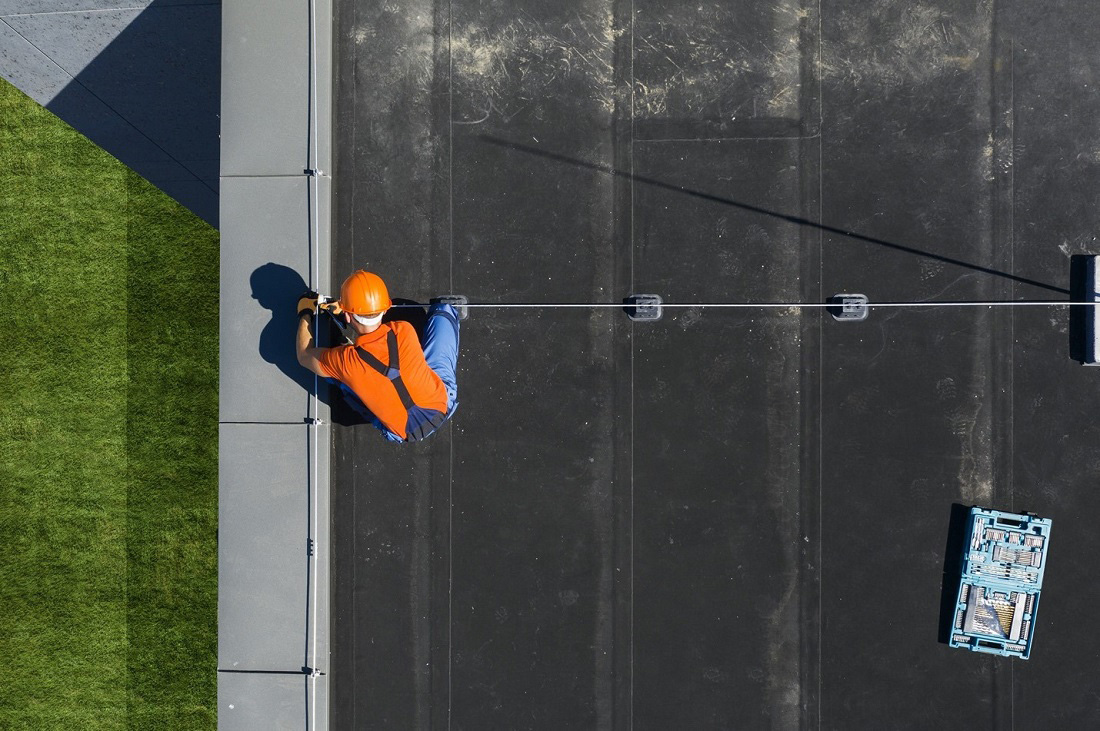
Before you begin roofing work, reach out to the electricians working on the lightning protection system and ensure that the two systems are compatible with one another. While you work, you may have the system or portions of it uninstalled and then reinstalled after you’ve completed your portion of the work.
If the system will be left in place while you work, ensure that your team is familiar with the system and its various elements and how to avoid disturbing or disconnecting them. It may be helpful to have some professional supervision from electrical professionals while you are working around lightning protection systems. Afterwards, the lightning system should be inspected in order to ensure it will still provide protection.
Common Problems for Roof Lightning Protection
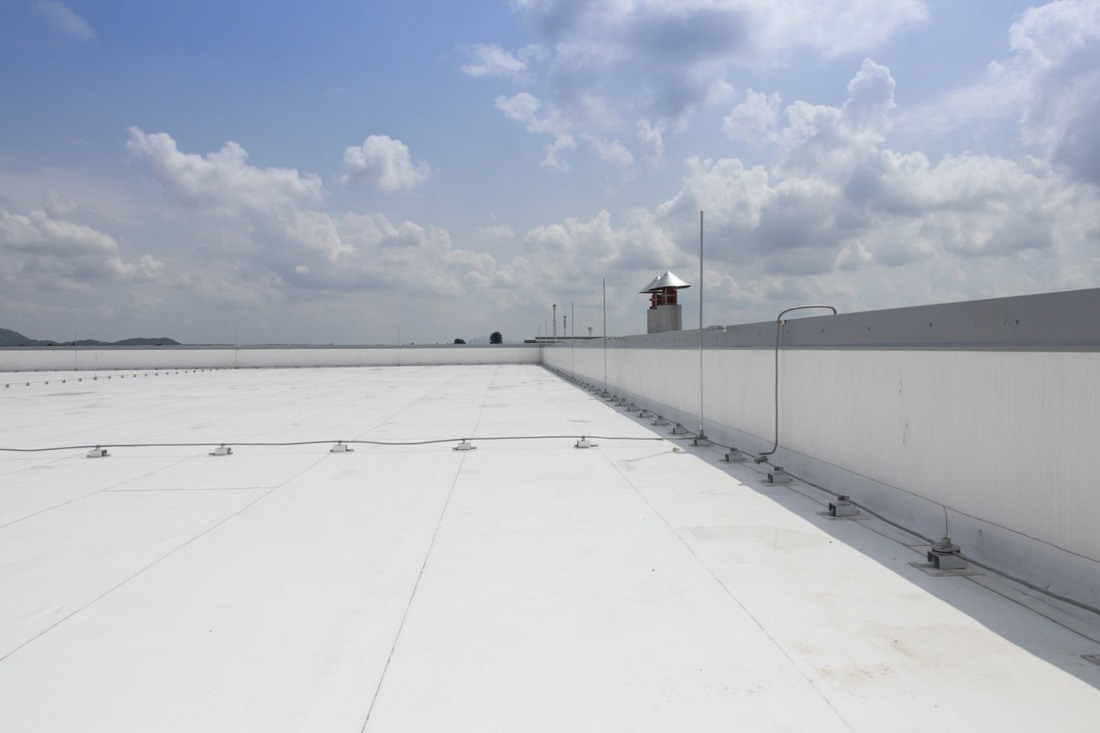
It is essential for roofers to understand the common problems that can occur when roofing systems and lightning protection systems are poorly integrated. These common problems include:
- Bitumen damage: If a conductor is directly on a bitumen roofing material, the conductor can sink into the surface due to heat, and therefore create a vulnerability in the roof.
- Surface abrasion: Detached connectors, or connectors with too much distance between them, can wear the surface of the roof. Wearing away the granules or polymers of the roof can limit the lifespan of the roof.
- Rooftop changes: Items that you add to the roof may need to be integrated into the lightning protection system. These additions may include HVAC equipment, satellites, security cameras, vents, and more.
- Heavy traffic: The more people that walk on the roof, the higher the chance that they accidentally disconnect a part of the lightning protection system.
There are several adjustments that can be made to lightning protection systems in order to make them easier to integrate with roofing systems. These include:
- Bi-metal fittings: When two metals come into contact with one another, they can cause degradation. You may need special bi-metal fittings in order to place the lightning protection system fittings onto metal parts of the roof, such as flashing.
- Swivel necks: Air terminals with swivel necks are available. They can be installed on a wider range of roof pitches than those with fixed bases.
- Spring-mounted bases: To limit the effect of traffic on the roof, some air terminal bases are equipped with springs.
What if you’re having challenges integrating the roofing system and the lightning protection system? You can always consider a lightning protection system that takes up less room on the roof and requires less direct contact with the roofing materials. A lightning attraction system is a good option, as it may require only one large rod.
Always Keep the Lightning Protection System in Mind
Before and after you complete roofing work, you should reach out to the professionals who installed or are installing the lightning protection system so that you can work together and adjust both systems to ensure that each functions properly. As the roofer, after your work is completed, you should arrange for the lightning protection system to be inspected both by facility maintenance and UL. Keep the building managers or owners updated about your work with the lightning professionals so that they know their building is protected.
If you’re a property owner, manager, or stakeholder who is concerned about how well your roof and lightning systems are integrated, a roofing professional can help. It is also a wise idea to have your roof inspected after a lightning strike for damage. Find the right roofing contractor for you through IKO’s Contractor Locator.
